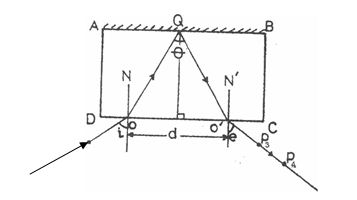|
|
Alternative a
Question 2
|
(a) Diagram

You are provided with a glass block, plane mirror and optical pins.
(i)Place the glass block on a drawing sheet and trace its outline ABCD as shown in the
diagram above.
(ii)Remove the block, measure and record the width W of the block.
(iii)Draw a normal ON to DC at a point about one-quarter the length of DC.
(iv)Draw a line making an angle I = 10° with the normal
(v)Replace the block on its outline and mount the plane mirror vertically behind the block
such that it makes good contact with the face AB.
(vi)Stick two pins PI and P2 on the line MO.
(vii) Looking through the face CD, stick two other pins P3 and P4 such that they appear to be
in a straight line with the images of pins PI and P2 seen through the block.
(viii) Join P3 and P4 with straight lien and extend it to touch the face CD at 01•
(ix)Draw a perpendicular line from the midpoint of 001 to meet AB at Q.
(x)Draw lines OQ, OlQ and normal 01N1 produced.
(xi)Measure and record, e and d.
(xii) Evaluate m = sin e and n = cos [~]-
(xiii) Repeat the procedure for I = 20°, 30°' 40° and 50°.
(xiv) Tabulate your readings
(xv) Plot a graph with m on the vertical axis and n on the horizontal axis.
(xvi) Determine the slope, s, of the graph and evaluate q = 2Ws.
(xvii) State two precautions taken to ensure accurate results
(Attach your traces to your answer booklet.)
|
| _____________________________________________________________________________________________________ |
|
(a)This question seem to be popular among the candidates, however, it was poorly attempted.
Some candidates just copied the diagrams as they appeared on the question paper without
actually performing the experiment. Some did not attach their traces while some traces do
not have the required pin holes.
(b) Part (b )(i) was poorly attempted. Though refractive index was well explained but expressing
it in terms of wavelengths was a mirage.
Part (b)(ii) was well attempted by majority of the responding candidates.
The expected answers are:
OBSERVATION [10)
(i) The width W of the glass block measured and recorded in em to at
least 1 decimal place.
(ii) 5 complete traces attached, showing at least incident and emergent rays,
the normals ON and 01 N1 , and the rays OQ and Q01 as illustrated in the diagram.
(iii) 5 values of the emergent angles e measured and recorded in Degrees.
(iv) 5 values of angle 6 measured and recorded in degrees
(v) 5 values of d measured and recorded in em to at least 1 decimal place
(vi)5 values of m = sine e) correctly evaluated to at least 3 decimal places
(vii) 5 values of n = cos(θ/2)correctly evaluated to at least 3 decimal places
(viii) Composite table showing i, θ, e, m and n
Note: I. if traces are bit attached, award zero for (i) - (v)
II. if traces are attached but no pin holes, award zero for (i) - (v)
GRAPH [06]
(i) Both axes correctly distinguished
(ii) Reasonable scales, Y:z mark each
(iii) Five points correctly plotted
(deduct 1 mark for each wrong or missing point)
(iv)Line of best fit
SLOPE [02]
(i) Large right-angled triangle
(ii)∆m correctly determined
(iii)∆h correctly determined
(iv)∆m/ ∆n correctly evaluated
EVALUATION (01)
Correct substitution q = 2Ws.
Correct arithmetic
PRECAUTIONS [02]
Award 1 mark each for any two correct precautions
e.g.
Neat traces
Pins located vertically
Pins reasonably spaced
Avoid parallax error on the protractor
Zero error avoided on the rule
(Accept any other valid precautions).
ACCURACY (01)
Based on teacher's value for refractive index
q = refractive index = 1.5 within + 5%
(b )(i) Refractive index is the ratio of the velocity of light in air to the velocity of light
in a medium when light waves pass from air to a material medium.
(Accept any other valid explanation).
Mathematically:
Where
λl = wavelength in air
λ2 = wavelength in the material
n = refractive index of the material.
(ii) The light must be travelling from a denser medium to a less dense medium.
The angle of incidence in the denser medium must be greater than the critical angle. |
|
|
|



